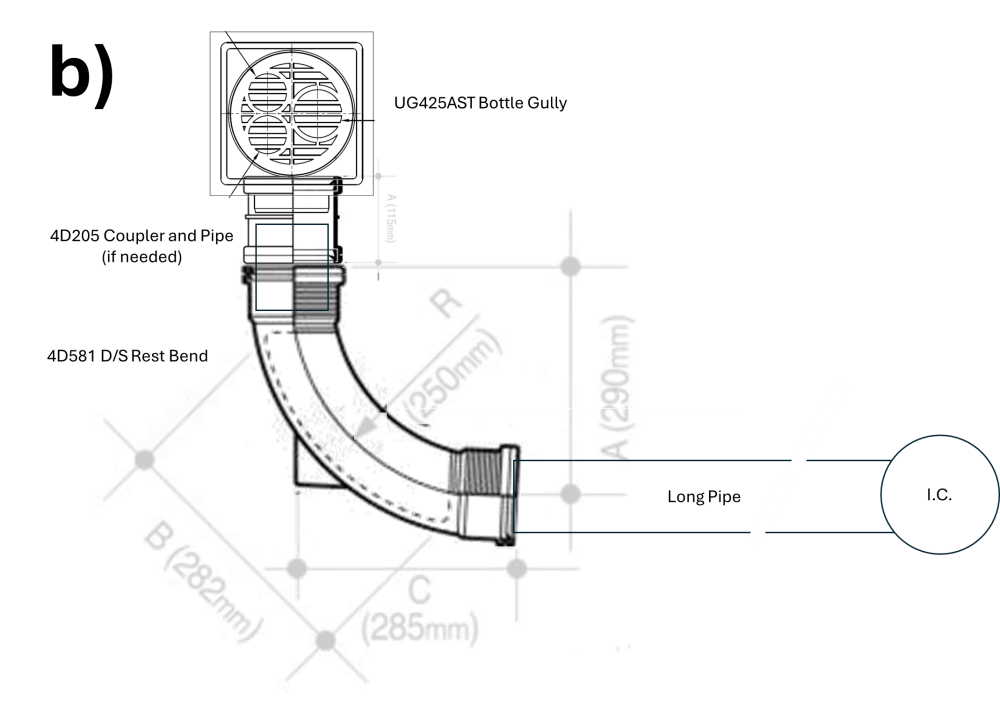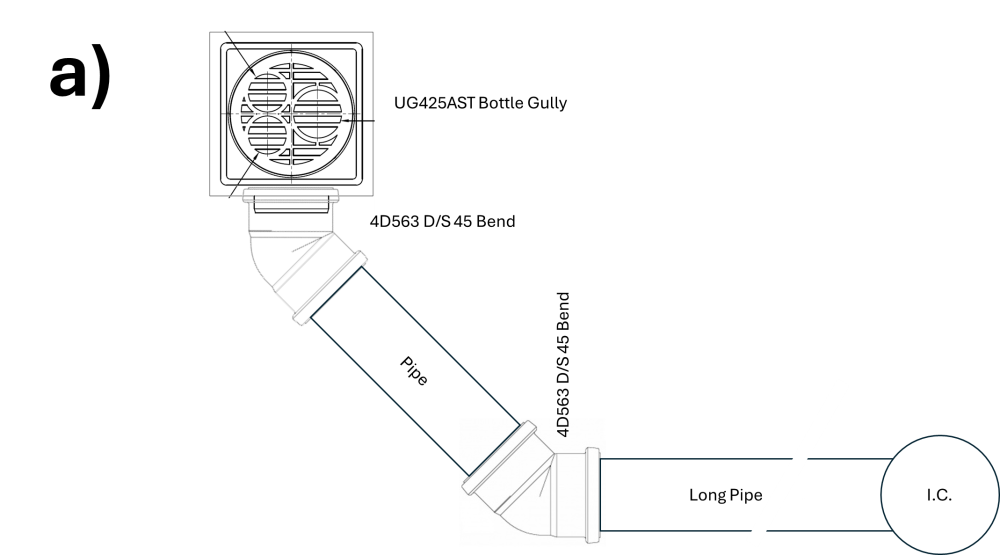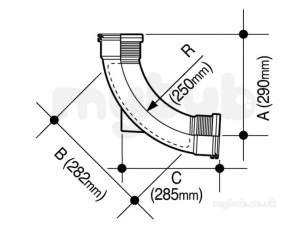
MortarThePoint
Members-
Posts
2157 -
Joined
-
Last visited
MortarThePoint's Achievements

Advanced Member (5/5)
238
Reputation
-
Rainwater Drainage Basics
MortarThePoint replied to MortarThePoint's topic in Rainwater, Guttering & SuDS
It's really a struggle to maintain 1:100 with a couple of turns. I've wondered about sending the (remaining) furthest downpipe (at 27m) on that run into a channel drain going along the edge of the house. That runs at the surface and you can get a 110mm end cap. That would buy me about 40mm if the channel was laid with a 1:100 fall or 80mm if laid level. 80mm would allow the remaining 22m to fall at (425 - 110 - 25) : 22000 = 1:76. A channel drain here is a bit random though. -
I was thinking the other day that a poor tiler can make expensive tiles look cheap, a good tiler can make expensive tiles look expensive but a great tiler can make cheap tiles look expensive. Hard to be sure, but from the picture the tiles themselves look fine.
-
I need to turn 90 degrees from my bottle gully without using an inspection chamber for the turn and see two main options for it: (a) use a 45 degree bend on the bottle gully and then a second 45 bend before the long pipe run (~5m). (b) use a rest bend either directly on the bottle gully or after a coupler and short length of pipe (will depend on trench position). Both should be roddable since the bottle gully can be rodded and there is an Inspection Chamber (I.C.) at the end of the long pipe (~5m). Can't you rod through a rest bend? If so, I lean towards option (b). (b) is also cheaper as I have a spare rest bend. What do others think? For full disclosure, the I.C. is a 4D960 shallow one and has two S/S 45 bends on it as it is at the corner of the house so the pipe turns. All these pipes will be paved over.
-
Rainwater Drainage Basics
MortarThePoint replied to MortarThePoint's topic in Rainwater, Guttering & SuDS
I'm a little disappointed to end up with Bottle Gullies rather than rest bends due to levels. I suspect Bottle Gullies could be a breeding ground for mosquitoes. -
For long straight runs, socketed pipes are useful though and have fewer seals. I've gone with Osma fittings and pipes. A pipe and coupler works out about £3 more than a socketed Floplast pipe. I asked and Floplast didn't recommend using the socket of a pipe as one of the sockets of a rocker pipe.
-
I have Osma rest bends which have an invert 290+50=340mm below top of socket. Clearance to house makes this run about 20m, call it 21m which would be a 350mm drop at 1:60. If I have the 250mm chamber 50mm below the 450mm chamber's invert (600mm bgl), that would be a depth of 650mm. It's not a compliant depth for that 250mm chamber, but BCO was OK with a junction so I can just bury the chamber under a removable slab. The invert at the rest bend would be 650 - 350 = 300mm bgl so the rest bend's socket will stick out of the ground. I'll paint that black. Should work, but have to check fall to STP to confirm. Top of pipe at the rest bend will be 190mm bgl, falling to 190 + (8,000/60) = 323mm at the turn. The rainwater pipe it needs to cross will have an invert depth of about 175 + (5,000/100) = 225mm or 175 + (5,000/80) = 238mm at this point, so 100mm or 85mm clearance between pipes. Rainwater pipe invert after 20m needs to be 425mm and can start at 175mm, so may be 1:80. Osma rest bend:
-
Rainwater Drainage Basics
MortarThePoint replied to MortarThePoint's topic in Rainwater, Guttering & SuDS
You'd hope. Osma in general does seem well made but certainly carries a premium. -
Rainwater Drainage Basics
MortarThePoint replied to MortarThePoint's topic in Rainwater, Guttering & SuDS
Sadly the only ideal world exists on the drawing board. I'm working to eliminate as much as I can. -
Rainwater Drainage Basics
MortarThePoint replied to MortarThePoint's topic in Rainwater, Guttering & SuDS
[couldn't fix the edit] I'm using Osma fittings so it would be their adjustable bend. Theirs and some others don't have anything you can tighten. -
Rainwater Drainage Basics
MortarThePoint replied to MortarThePoint's topic in Rainwater, Guttering & SuDS
I'm using Osma fittings so it would be their adjustable bend. Theirs and some others don't have anything you can tighten. Aiyden Project had a nightmare with his Floplast ones which can be tightened, though I've seen a video that says they come pre tightened if you believe that. Floplast's adjustable output inspection chambers look cool, but I'd be nervous of leaks if using them. -
Rainwater Drainage Basics
MortarThePoint replied to MortarThePoint's topic in Rainwater, Guttering & SuDS
I've read elsewhere that adjustable bends "always leak". Is there any truth to that? -
Rainwater Drainage Basics
MortarThePoint replied to MortarThePoint's topic in Rainwater, Guttering & SuDS
I have a Roughneck Tamp from previous adventure thankfully. In other sections of the trench, it is passing through areas where I had covered the foundation back fill with a very generous layer of MOT for the scaffolding to sit on. -
Rainwater Drainage Basics
MortarThePoint replied to MortarThePoint's topic in Rainwater, Guttering & SuDS
@Nickfromwales I've got a bit carried away digging the trenches on my own and didn't notice that at the far end of one branch the starting ground level hasn't yet been brought up to final ground level. It was also soft soil here so easy digging. The upshot is that for the first section I have dug the trench about 200mm deeper than needed (so 300mm below bottom of pipe). I have loads of 10mm gravel as I had a tipper load rather than grab bags. What should I do: Mistake is no issue, just fill trench with 10mm gravel all the way up to underside of pipe, lay pipe as normal Fill trench to the depth I should have dug to (100mm below pipe) with 10mm gravel in 100mm layers, tamp between fills. Then lay pipe a normal Fill trench to the depth I should have dug to (100mm below pipe) with as dug soil in 100mm layers, tamp between fills. Then lay pipe a normal Fill trench to the depth I should have dug to (100mm below pipe) with MOT rich soil in 100mm layers, tamp between fills. Then lay pipe a normal Thankfully this is for the shorter branch that is going to be 1:80 fall. There is a 250mm inspection chamber in this section though.





